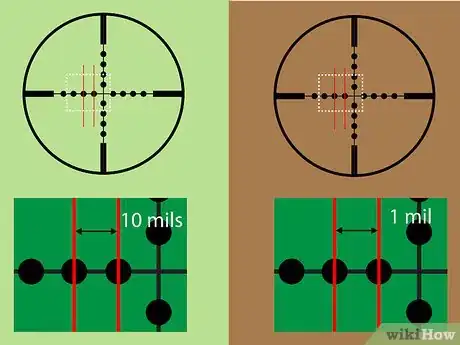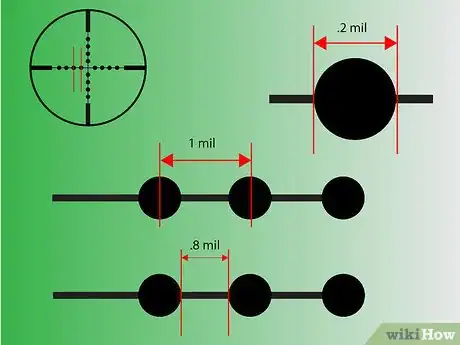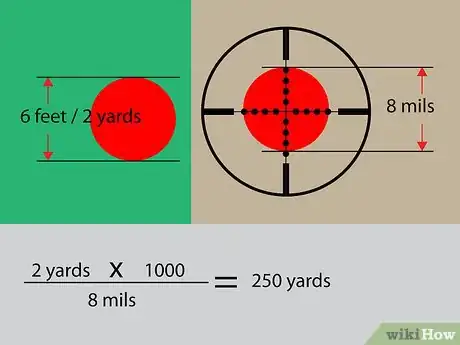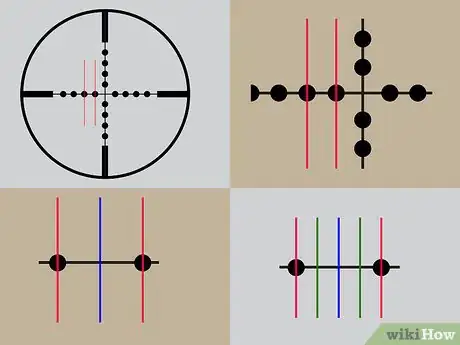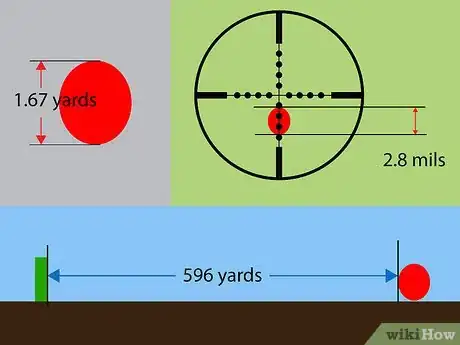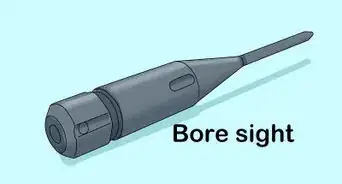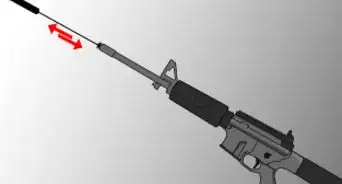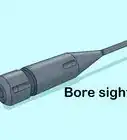wikiHow is a “wiki,” similar to Wikipedia, which means that many of our articles are co-written by multiple authors. To create this article, 16 people, some anonymous, worked to edit and improve it over time.
wikiHow marks an article as reader-approved once it receives enough positive feedback. In this case, 91% of readers who voted found the article helpful, earning it our reader-approved status.
This article has been viewed 481,538 times.
Learn more...
Mil Dot scopes are optics which allow users to easily calculate distances to a target without fancy equipment. Originally used by submarine periscopes, it has been scaled and re-implemented for military and recreational rifle marksmen to determine distance objects or to allow for bullet drop compensation. Once the basics are learned, calculating distances can be quick and painless using Mil Dots.
Steps
Background
-
1Binocular and periscope Mil Dots are not the same as rifle scope Mil Dots. They measure the same type of angular distance, but is actually 10 Mils instead of only one, which is more suited for marksmen use.
-
2A Mil is 1-6,175 of a circle. But to simplify calculations, the U.S. military calculates them as 1-6283 of a circle[1] (previously 1-6400 on older scopes). Russian-based scopes are set to 1-6,000 of a circle. This means there is up to a 3% error in distance calculations.Advertisement
-
3When looking at Mil Dots through a scope, one Mil is the distance from the center of one dot, to the center of the next dot (not the space between the dots).[2] Each dot is .2mil and the space between the dots is .8mil for the round army type mil dot reticle.
-
4Mil distances on rear-plane cross hairs on a variable-power scope usually are only accurate at the highest power.
Measuring Distance
-
1Calculate the distance to the object by multiplying the height (or width) of the object by 1000 then dividing by the number of Mils that the object spans.[3]
- For example: a six foot tall object (2-yards) which is eight Mils in size is 250-yards away. 2 x 1000 / 8 = 250.
-
2Calculate as accurately as possible, and any "added error" (by yourself) is error in distance that may not be acceptable.[4]
- Sub-divide the Mil Dots as much as possible, and be as accurate in estimating the size of the object as possible.
- The object is five feet (1.67-yards) wide and spans 2.8 Mils is 596-yards away.
- A guess that the object is 2-yards instead of 1.67 would mean the estimation of over 100 yards difference which could mean a hit, or a miss of over five inches with a standard .308.
- To be in the right mindset, calculate sizes of objects to the tenth of a yard (is that 3.4-yards or 3.5?). Calculate the span in Mils also to the tenth of a Mil. Both of these will take practice, but perfect estimations is the only way to get perfect range calculation.
-
3Use a calculator if needed. Some equations might get pretty complex, and accuracy is key, but the speed of a calculator may also help in some situations.
Community Q&A
-
QuestionWhy do you multiply by 1000 in the formula?
 Community AnswerMil stands for milliradian, so to get it to radians, you must multiply by 1000.
Community AnswerMil stands for milliradian, so to get it to radians, you must multiply by 1000. -
QuestionIs a bullet drop not part of the mil dot ranging?
 Community AnswerBullet weights and loads vary, so you might need to do a little of your own math and keep a record for height adjustments.
Community AnswerBullet weights and loads vary, so you might need to do a little of your own math and keep a record for height adjustments. -
QuestionCan I use a normal mobile phone or camera to do this?
 Community AnswerYes, if your mobile phone has a calculator, and you have the formula. Calculator apps are also available and are free to download on Google play and in the Apple play store.
Community AnswerYes, if your mobile phone has a calculator, and you have the formula. Calculator apps are also available and are free to download on Google play and in the Apple play store.
Warnings
- Sloppy range estimate comes from sloppy estimation of size of the target and span of Mils.⧼thumbs_response⧽
- Be sure to follow all state and local laws while shooting. Note that many laws on firearms change drastically from state to state, and can even change between counties or even cities.⧼thumbs_response⧽
- Firearms can be very dangerous and even lethal. They should only be used by experienced firearm users or under the direct supervision of an expert firearm instructor.⧼thumbs_response⧽
References
- ↑ https://www.targettamers.com/guides/mil-dot-explained/
- ↑ https://www.trijicon.com/na_en/support/how_to_use_mil_dot.php
- ↑ https://www.marines.mil/Portals/1/Publications/MCTP%203-01E%20%28Formerly%20MCWP%203-15.3%29.pdf?ver=2016-08-02-130206-573
- ↑ https://www.targettamers.com/guides/mil-dot-explained/
- ↑ https://www.trijicon.com/na_en/support/how_to_use_mil_dot.php
About This Article
To calculate distance using a mil dot rifle scope, multiply the object’s height or width by 1000, then divide that number by the number of mils the object spans in your scope. For example, if you know a tree is 6 feet tall, but appears to be 8 mils in your scope, the object is 750 feet away. Since a mil is exactly the distance between the centers of the dots, you can compare an object to these dots to determine how many mils it is. Keep reading to learn how to account for error and be more accurate in your estimates!
